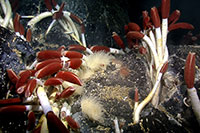Deep-Sea Biologist
Description
 Over 70% of the earth is covered by ocean, and the deep-sea habitat is largely unexplored. Deep-sea biologists are, therefore, scientists and underwater explorers. The deep-sea is defined as the part of the ocean below 200 m (656 ft) depth. In this environment, temperatures are below 5°C (41°F), pressures are extreme, and there is no sunlight. Deep-sea animals exhibit unusual and unique adaptations, to live, reproduce, and thrive in these unique conditions. Advances in technology are allowing scientists to learn more about the habitats and marine life that exist in these extreme environments.
Over 70% of the earth is covered by ocean, and the deep-sea habitat is largely unexplored. Deep-sea biologists are, therefore, scientists and underwater explorers. The deep-sea is defined as the part of the ocean below 200 m (656 ft) depth. In this environment, temperatures are below 5°C (41°F), pressures are extreme, and there is no sunlight. Deep-sea animals exhibit unusual and unique adaptations, to live, reproduce, and thrive in these unique conditions. Advances in technology are allowing scientists to learn more about the habitats and marine life that exist in these extreme environments.
Education Requirements
Estimated Salary
- B.S. in biology, oceanography, or related field for most entry-level jobs
- Graduate degree in marine biology physical or biological oceanography often needed for advancement
- PhD in an above field is necessary for most independent research and for college teaching jobs
For salary information, please visit the United States Bureau of Labor Statistics
Tasks and Duties
Deep-sea biologists may have a variety of responsibilities depending on the specific nature of their job. These could include:
- Examine and explore deep-ocean habitats, animals, and microorganisms
- Study the physiological adaptations of organisms in the deep-sea environment
- Map the seafloor
- Analyze and interpret data
- Write research papers, technical reports, and scholarly articles that explain research findings
Knowledge and Skills
Basic skills might include:
- Strong research skills
- Experimental design and application (in a laboratory and field setting)
- Data collection, management, and analysis (including statistical analysis)
- Knowledge of oceanographic technology and tools (trawls, dredges, remotely operated vehicles (ROVs), autonomous underwater vehicles (AUVs), side scan sonar, multibeam sonar)
- Research cruises often involve a wide variety of scientists and crew. At-sea biologists must be able to work effectively with others (in a confined location).
May need knowledge in:
• Biology
• Chemistry
• Computer science
• Geology
• Ecology
• Marine biology
• Micro/ Molecular biology
• Physics
• Statistics
Connections to Underwater Acoustics
Deep-sea biologists may use acoustic technologies in their work. One of the best systems for imaging large areas of the ocean floor is side scan sonar. Side scan sonar technology provides high resolution, almost photographic quality imagery of the seafloor. The technology uses a specially shaped acoustic beam, which pulses out 90 degrees from the path that it is towed, and also out to each side. Each pulse provides a detailed image of a narrow strip directly below and to either side of the instrument. The topography of the ocean floor and underwater objects reflect sound energy back to hydrophones on the towfish. These reflections are amplified, processed, and displayed as images. Multibeam sonar systems produce many beams of sound at the same time to cover a large fan-shaped area of the ocean floor, which produces high-resolution bathymetry data throughout a survey area. Since they acquire dense sounding data both along the ship’s track and between the track lines, they can provide 100% coverage of the seafloor. Multibeam sonar is used to locate topographical features on the seafloor such as sediment ridges, rock outcrops, shipwrecks, and underwater cables.
Cable-linked seafloor observatories allow scientists to study and monitor the deep ocean. Cabled ocean observatories include a vast, integrated network of oceanographic sensors that measure physical, chemical, geological, and biological variables, including underwater acoustics, in the ocean and seafloor. Cabled ocean observatories include the ALOHA Observatory (ACO) 100 km (60 mi) north of Oahu. In addition to ocean sounds, the ALOHA Observatory continually obtains observations of temperature, salinity, and ocean currents, which are shared in real time with the oceanographic community and the general public. The Regional Scales Nodes project, will consist of 900 km of cable across the Juan de Fuca tectonic plate in the Pacific Ocean to investigate processes such as ocean acidification, seismic activity, spreading centers, habitat characterization, and coastal upwelling. Listen to the Deep Ocean Environment (LIDO) is an international passive acoustic monitoring project maintained by the Laboratory of Applied Bioacoustics (LAB) of the Technical University of Catalonia. The project involves processing real-time data streams from cabled deep-sea platforms and moored stations across the globe to detect, classify, and localize natural, biological, and anthropogenic sounds.
Related Careers
- Biological Oceanographer
- Marine Biologist
- Marine Biotechnologist
- Marine Ecologist
- Molecular Biologist
- Ocean Engineer
- Plankton Biologist
DOSITS Links
People and Sound
Navigation> How is sound used to navigate underwater?
Technology Gallery
Basic Technology > Hydrophone
Observing the Seal Floor> Multibeam Echosounder
Observing the Seal Floor> Side Scan Sonar
Observing and Monitoring Marine Animals > Real-time Passive Acoustic Sensors
Resources
- WHOI: Dive and Discover: Deep Sea Biology
- NOAA Ocean Explorer, Amy Baco-Taylor Career Profile (deep-sea biologist)
- Deep Sea News: So you want to be a marine biologist